The Needle Galaxy is a barred spiral galaxy located approximately 30 – 50 million light-years away in the constellation Coma Berenices. It is one of the best-known edge-on spiral galaxies in the night sky. The galaxy is catalogued as NGC 4565 in the New General Catalogue and Caldwell 38 in the Caldwell catalogue of deep sky objects visible in amateur telescopes.
The Needle Galaxy has an apparent magnitude of 10.42 and an apparent size of 15.9 by 1.85 arcminutes. It was named for its narrow appearance. The galaxy appears almost exactly edge-on when seen from Earth. It lies in the same region of the sky as the Coma Star Cluster, not far from the North Galactic Pole. It is one of the brightest members of the Coma I Group of galaxies.
The giant spiral galaxy has a bright yellowish central bulge glowing behind prominent dust lanes that cut across the galactic core. The presence of the central bar was confirmed by observations with the Spitzer Space Telescope, which also revealed the existence of a pseudobulge within the box-shaped bulge. The Milky Way would appear similar if it were seen from the same angle.
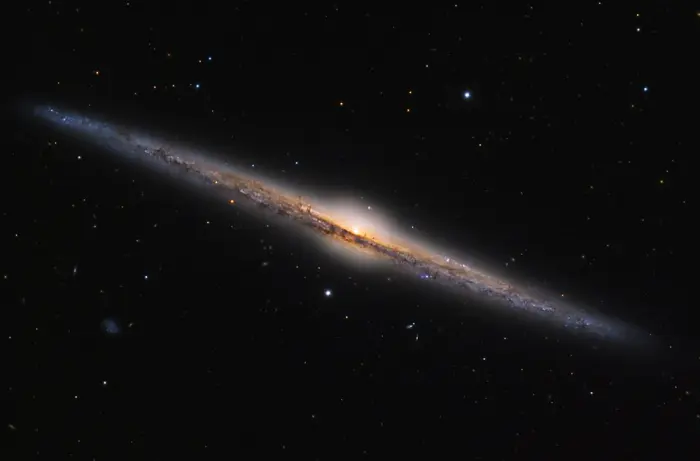
The Needle Galaxy (NGC 4565), image credit: Adam Block/Mount Lemmon SkyCenter/University of Arizona (CC BY-SA 4.0)
NGC 4565 is the brightest and finest edge-on spiral galaxy in the sky. It is more luminous than the Andromeda Galaxy (Messier 31), but similar in size. It contains about 240 globular clusters, more than our own Milky Way galaxy. These clusters stand out in images because the galaxy appears edge-on.
The Needle Galaxy is the second-brightest galaxy in the Coma I Group. The galaxy group appears in the same region of the sky as the Coma Star Cluster (Melotte 111), a nearby open cluster that dominates the western portion of Coma Berenices.
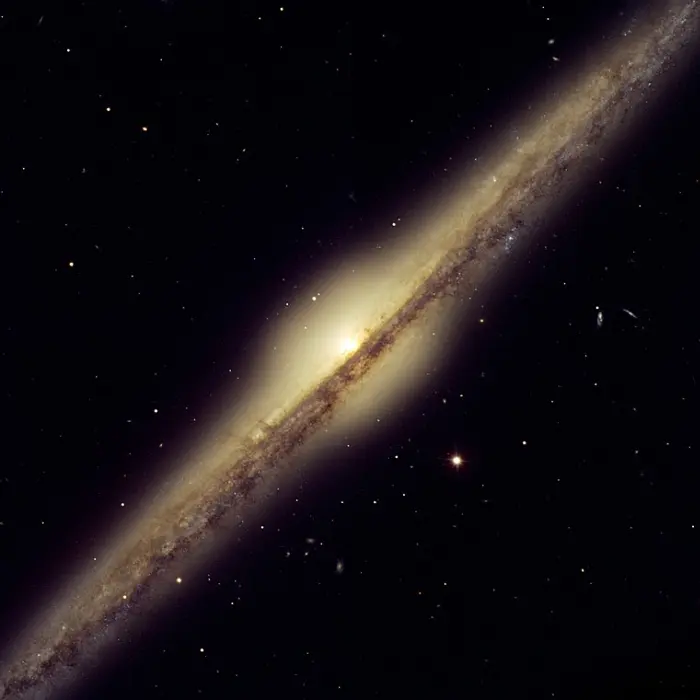
The galaxy pictured here is NGC 4565, which for obvious reasons is also called the Needle Galaxy. First spotted in 1785 by Uranus’ discoverer, Sir William Herschel (1738-1822), this is one of the most famous example of an edge-on spiral galaxy and is located some 30 million light-years away in the constellation Coma Berenices (Berenice’s Hair). It displays a bright yellowish central bulge that juts out above most impressive dust lanes. Because it is relatively close (it is only 12 times farther away than Messier 31, the Andromeda Galaxy, which is the major galaxy closest to us) and relatively large (roughly one third larger than the Milky Way), it does not fit entirely into the field of view of the FORS instrument (about 7 x 7 arcmin2). Many background galaxies are also visible in this FORS image, giving full meaning to their nickname of “island universes”. Image credit: ESO (CC BY 3.0)
The center of the Coma I Group lies approximately 47.3 light-years from the solar system. The group contains mostly spiral galaxies, with few lenticular and elliptical members. The brightest galaxy in the group, the intermediate barred spiral galaxy NGC 4725, has an apparent magnitude of 10.1. It appears east of the Needle Galaxy.
The Coma I Group lies within the Virgo Supercluster. It is currently infalling into the Virgo Cluster and will eventually merge with it.
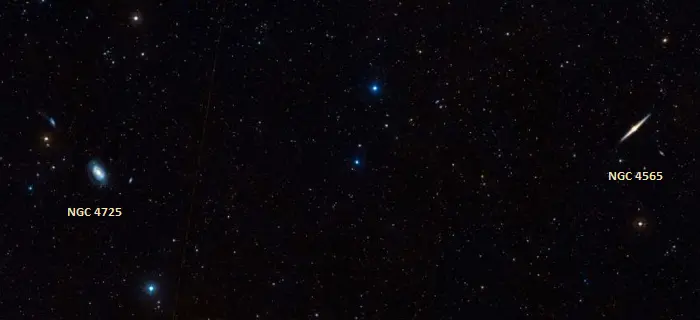
NGC 4725 and NGC 4565, image: Wikisky
Facts
The Needle Galaxy was discovered by the German-born British astronomer Sir William Herschel on April 6, 1785. Herschel discovered the brighter NGC 4725 on the same day.
NGC 4565 has at least two smaller satellite galaxies and is interacting with one of them. The galaxy has a slightly warped and extended disk, likely a result of the interaction with the smaller galaxies and other members of the Coma I Group.
The Needle Galaxy was imaged with the NASA and ESA Hubble Space Telescope as part of Hubble’s Caldwell Catalog series.

Caldwell 38 is nicknamed the Needle galaxy, because in most telescopes it looks as thin and sharp as a pin. It is a spiral galaxy, but because it is seen almost perfectly edge-on, its spiral structure is concealed. This Hubble image, taken with the Wide Field and Planetary Camera 2, provides a detailed look near the galaxy’s core, which is largely obscured by thick ribbons of dust in the spiral arms. These observations were taken to search for large groupings of old stars, known as globular clusters, in Caldwell 38. Seeing the Needle galaxy edge-on provides an excellent opportunity to explore globular star clusters. While most of a spiral galaxy’s stars lie within a relatively flat plane, globular clusters tend to be sparsely distributed all around the galaxy, surrounding it like a diffuse shell. When seen face-on, a galaxy’s globular clusters easily get lost in the mix; when a galaxy is seen edge-on, however, these clusters stand out. Image credit: NASA, ESA and K. Ashman (University of Missouri); Processing: Gladys Kober (NASA/Catholic University of America)
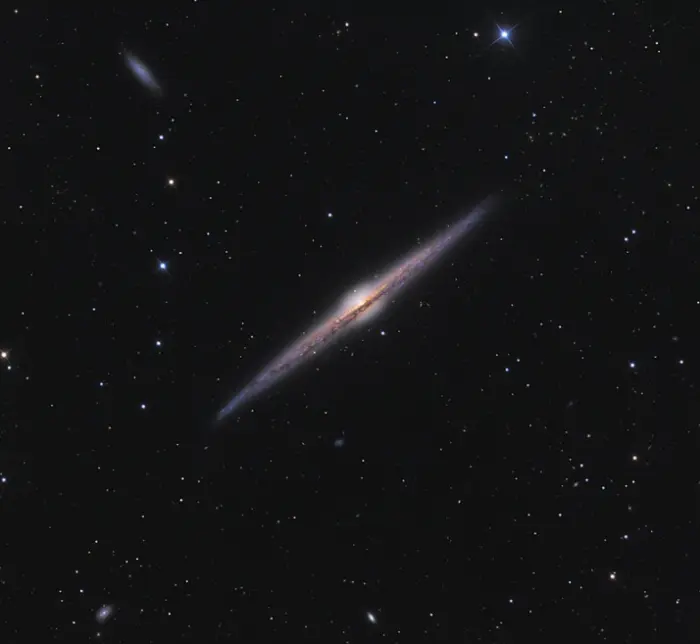
NGC 4565, image credit: Ken Crawford (CC BY-SA 3.0)
Location
The Needle Galaxy appears in the same line of sight as the Coma Berenices Cluster, an open cluster that stretches across 7.5 degrees of the sky and occupies a good portion of Coma Berenices. The galaxy lies 3 degrees southeast of Gamma Comae Berenices, the brightest star in the constellation, and about 3 degrees from the North Galactic Pole. The orange giant is the brightest star in the region between Cor Caroli in Canes Venatici and Denebola in Leo.
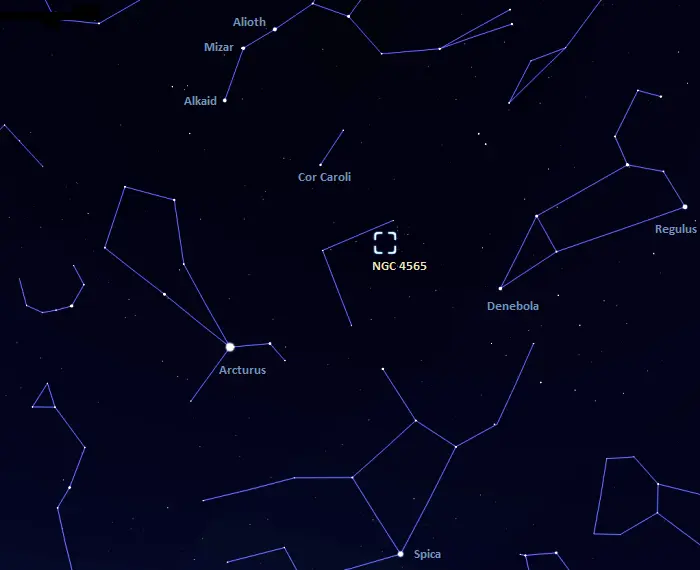
The location of the Needle Galaxy, image: Stellarium
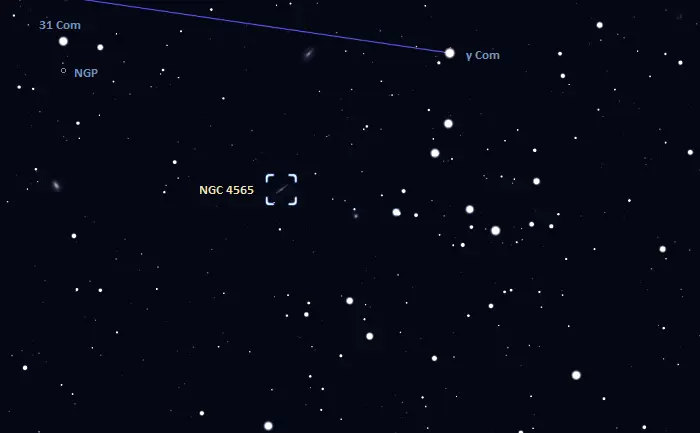
NGC 4565 location, image: Stellarium
The best time of the year to observe the Needle Galaxy and other galaxies in Coma Berenices is during the month of May, when the constellation is high above the horizon in the evening.
The Needle Galaxy can be spotted in small telescopes. It appears as a very narrow streak of light contrasted against the dark sky at the eastern edge of the Coma Berenices Cluster. The central bulge may be seen in 4-inch telescopes in good conditions but is better viewed in larger instruments. An 8-inch telescope will reveal the bright nucleus and hints of the dark dust lane. The details in the dark lane can be observed in larger telescopes. A 14-inch telescope may reveal a satellite galaxy, NGC 4562, about a quarter of a degree west-southwest of NGC 4565.
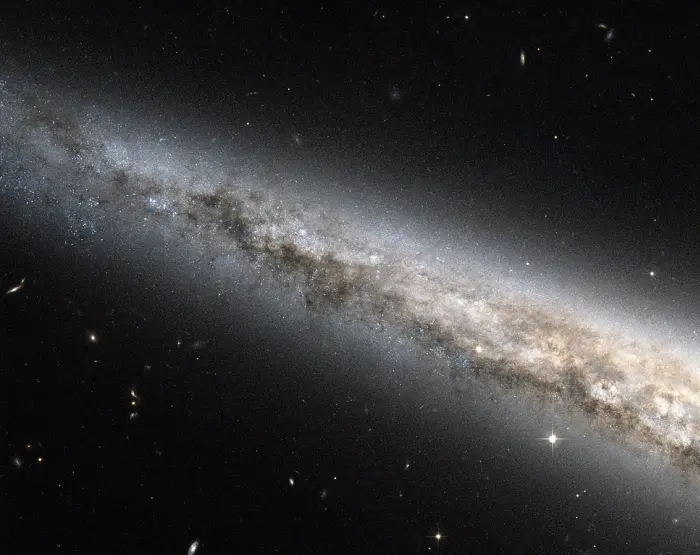
This spear of stars and dust, imaged in visible and infrared light with Hubble’s Advanced Camera for Surveys, is a zoomed-in view of one side of Caldwell 38. The galaxy’s core lies toward the lower right, beyond the edge of this image. Credit: ESA/Hubble & NASA
Needle Galaxy – NGC 4565
| Constellation | Coma Berenices |
| Right ascension | 12h 36m 20.8s |
| Declination | +25° 59′ 16″ |
| Apparent magnitude | 10.42 |
| Apparent size | 15′.90 × 1′.85 |
| Distance | 42.7 ± 12 million light-years (13.1 ± 3.7 megaparsecs) or 53 ± 4 Mly (16.2 ± 1.3 Mpc) |
| Type | SA(s)b? |
| Redshift | 0.004103 |
| Helio radial velocity | 1,230 ± 5 km/s |
| Names and designations | Needle Galaxy, NGC 4565, Caldwell 38, PGC 42038, UGC 7772 |
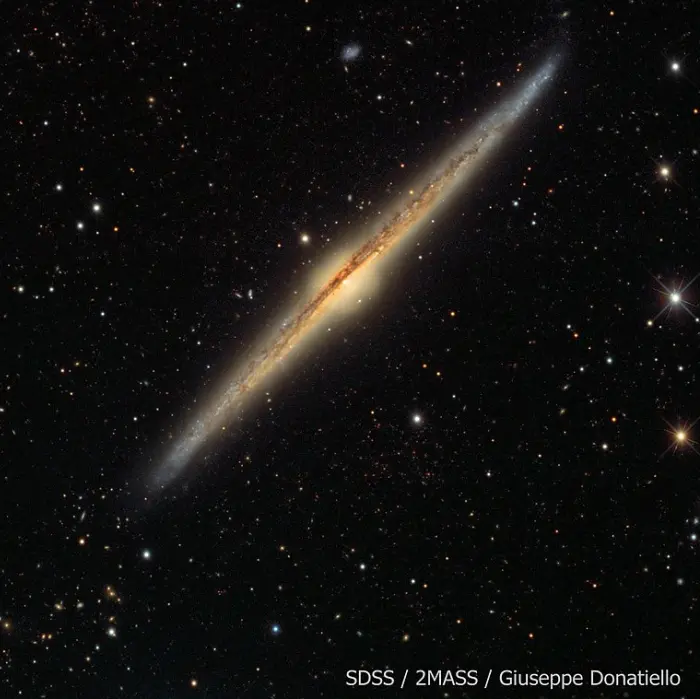
The Needle Galaxy, image credit: Giuseppe Donatiello (CC0 1.0)
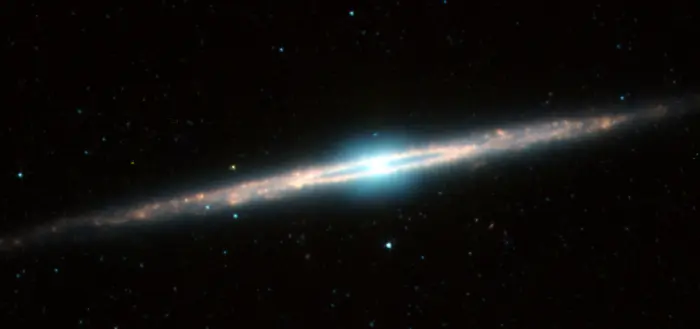
The Needle Galaxy by the Spitzer Space Telescope, image credit: Serge Meunier (CC BY 2.0)